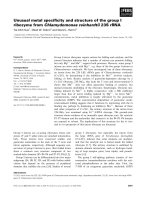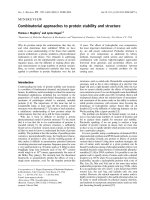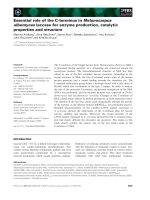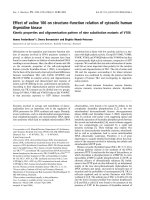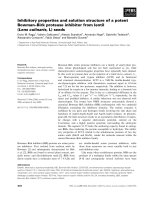Nuclear properties and structure
Bạn đang xem bản rút gọn của tài liệu. Xem và tải ngay bản đầy đủ của tài liệu tại đây (648 KB, 11 trang )
Tiểu luận: Tiếng Anh chuyên ngành - Khoa Vật lý - Đại học Đà Lạt
TRƯỜNG ĐẠI HỌC ĐÀ LẠT
KHOA VẬT LÝ
BÁO CÁO CUỐI HỌC PHẦN
TIẾNG ANH CHUYÊN NGÀNH
Giảng viên hướng dẫn:
Học viên thực hiện:
Lớp:
MSSV:
Giảng viên hướng dẫn: Đà Lạt, tháng 11 năm 2023 Trang 2
Tiểu luận: Tiếng Anh chuyên ngành - Khoa Vật lý - Đại học Đà Lạt
TABLE OF CONTENTS
I. Nuclear structure..............................................................................................................3
II. Nuclear symbol................................................................................................................4
III. Nuclear isotopes.............................................................................................................5
IV. Nuclear mass..................................................................................................................6
1. Atomic mass unit...........................................................................................................6
2. Integer mass and energy...............................................................................................6
V. Nuclear force.................................................................................................................... 7
VI. Nuclear binding energy.................................................................................................7
1. Mass defect of the nucleus............................................................................................7
2. Nuclear binding energy................................................................................................8
3. Specific binding energy of the nucleus........................................................................9
Giảng viên hướng dẫn: Trang 3
Tiểu luận: Tiếng Anh chuyên ngành - Khoa Vật lý - Đại học Đà Lạt
NUCLEAR PROPERTIES AND STRUCTURE
I. Nuclear structure.
Nuclear structure refers to the organization and arrangement of protons and neutrons
within an atomic nucleus. Here are some key points about nuclear structure:
1. Protons and Neutrons: Atomic nuclei are composed of protons and neutrons,
collectively called nucleons. Protons carry a positive charge, while neutrons have no charge.
The number of protons determines the atomic number and the element's identity, while the
total number of nucleons (protons + neutrons) determines the mass number.
2. Nuclear Force: The strong nuclear force is responsible for holding the nucleons
together within the nucleus. It is an attractive force that overcomes the electromagnetic
repulsion between protons. The strong nuclear force acts over very short distances and is
stronger than the electromagnetic force.
3. Shell Structure: Similar to electron shells in atoms, nucleons in the nucleus occupy
different energy levels or shells. These shells are organized into energy levels known as
shells, subshells, and orbitals. The shell structure of the nucleus influences its stability and
behavior.
Giảng viên hướng dẫn: Trang 4
Tiểu luận: Tiếng Anh chuyên ngành - Khoa Vật lý - Đại học Đà Lạt
4. Magic Numbers: Certain numbers of protons or neutrons, known as magic numbers
(2, 8, 20, 28, 50, 82, 126), correspond to particularly stable configurations in the nucleus.
Nuclei with magic numbers tend to be more stable and have higher binding energies.
5. Nuclear Size: The size of a nucleus is typically described by its radius, which is
much smaller than the overall size of an atom. The radius of a nucleus increases with the
mass number but does not increase proportionally.
6. Isotopes: Isotopes are atoms of the same element that have the same number of
protons but different numbers of neutrons. Isotopes have similar chemical properties but
may vary in their nuclear stability and radioactive behavior.
7. Nuclear Shapes: Nuclei can have different shapes, including spherical, ellipsoidal,
or deformed shapes. The shape of a nucleus depends on the arrangement of protons and
neutrons within it.
Understanding nuclear structure is essential for studying nuclear reactions, nuclear
decay, and nuclear properties. It provides insights into the stability, behavior, and properties
of atomic nuclei.
II. Nuclear symbol.
A nuclear symbol is a notation used to represent a specific nuclide or isotope of an
element. It consists of the element's symbol, atomic number, and mass number. Here's how
a nuclear symbol is written:
1. Element Symbol: The element symbol represents the specific chemical element. It is
usually a one- or two-letter abbreviation derived from the element's name. For example, "H"
represents hydrogen, "O" represents oxygen, and "U" represents uranium.
2. Atomic Number: The atomic number (Z) represents the number of protons in the
nucleus of an atom. It is usually written as a subscript to the left of the element symbol. For
example, "H" with an atomic number of 1 is written as ₁H.H.
3. Mass Number: The mass number (A) represents the total number of protons and
neutrons in the nucleus of an atom. It is usually written as a superscript to the left of the
element symbol. For example, "H" with a mass number of 2 is written as ²H.
Giảng viên hướng dẫn: Trang 5
Tiểu luận: Tiếng Anh chuyên ngành - Khoa Vật lý - Đại học Đà Lạt
Put(ting) it all together, the nuclear symbol for a specific isotope can be written as
follows:
ZA X
Here, "X" represents the element symbol, "A" represents the mass number, and "Z"
represents the atomic number.
For example, the nuclear symbol for a helium-4 isotope (2 protons and 2 neutrons) is
written as:
24 He
Please note that the atomic number is sometimes omitted if the element symbol is
known, as it can be determined from the element's position on the periodic table.
III. Nuclear isotopes.
Nuclear isotopes are different forms of an element that have the same number of
protons but different numbers of neutrons in their atomic nuclei. This results in variations in
the atomic mass of the element. Isotopes can be stable or unstable (radioactive).
Nuclear isotopes have various applications in different fields. In medicine, radioactive
isotopes are used in diagnostic imaging, such as PET scans, and in cancer treatments. In
industry, isotopes are used for radiography, sterilization, and thickness gauging. In
agriculture, isotopes are used for studying plant growth and nutrient uptake.
Isotopes also play a crucial role in nuclear power generation. Some isotopes, such as
uranium-235 and plutonium-239, are used as fuel in nuclear reactors. These isotopes
undergo nuclear fission, releasing a large amount of energy.
It is important to handle radioactive isotopes with caution due to their potential health
hazards. Strict regulations and safety protocols are in place to ensure their safe use.
Giảng viên hướng dẫn: Trang 6
Tiểu luận: Tiếng Anh chuyên ngành - Khoa Vật lý - Đại học Đà Lạt
IV. Nuclear mass.
1. Atomic mass unit.
An atomic mass unit (amu) is a unit of mass used to express the relative masses of
atoms and molecules. It is defined as one-twelfth the mass of a carbon-12 atom. The atomic
mass unit is also known as the Dalton (Da).
The amu is used to compare the masses of different atoms and molecules. It provides a
convenient scale for expressing atomic and molecular masses, as the actual masses of atoms
and molecules are extremely small and difficult to work with on a macroscopic scale.
The atomic mass unit is based on the fact that atoms of different elements have
different masses, with carbon-12 chosen as the reference point. For example, a hydrogen
atom has a mass of approximately 1 amu, while an oxygen atom has a mass of
approximately 16 amu.
The atomic mass unit is commonly used in chemistry and atomic physics to calculate
molecular and atomic weights, as well as in mass spectrometry to determine the mass-to-
charge ratio of ions.
2. Integer mass and energy.
Mass and energy are fundamental concepts in physics.
Mass is a measure of the amount of matter in an object. It is typically measured in
kilograms (kg) or grams (g). In the context of atomic and subatomic particles, the mass is
often expressed in atomic mass units (amu) or electron volts (eV). Mass is a scalar quantity,
meaning it has magnitude but no direction.
Energy, on the other hand, is the ability to do work or cause change. It is measured in
joules (J) or electron volts (eV). Energy exists in various forms, such as kinetic energy
(associated with motion), potential energy (associated with position or configuration), and
thermal energy (associated with temperature). Energy is a scalar quantity.
The relationship between mass and energy is described by Einstein's famous equation,
E=mc², where E represents energy, m represents mass, and c represents the speed of light in
a vacuum (approximately 3 x 10^8 meters per second). This equation states that mass and
energy are interchangeable and can be converted from one form to another.
In the context of atomic and nuclear physics, the mass-energy equivalence is
particularly significant. It means that a small amount of mass can be converted into a large
amount of energy, as observed in nuclear reactions and the release of energy in nuclear
power plants or atomic bombs.
In summary, mass and energy are related concepts in physics, with mass being a
measure of matter and energy being the ability to do work or cause change. The relationship
between mass and energy is described by Einstein's equation, E=mc², which shows that
mass can be converted into energy and vice versa.
Giảng viên hướng dẫn: Trang 7
Tiểu luận: Tiếng Anh chuyên ngành - Khoa Vật lý - Đại học Đà Lạt
V. Nuclear force
The nuclear force, also known as the strong force, is one of the four fundamental
forces of nature. It is responsible for holding the nucleus of an atom together by overcoming
the electromagnetic repulsion between protons. The nuclear force is very strong, but it has a
very short range, only acting within the nucleus itself.
The nuclear force is mediated by particles called gluons, which are exchanged between
quarks, the fundamental particles that make up protons and neutrons. This force is much
stronger than the electromagnetic force at very short distances, but it rapidly decreases as
the distance between particles increases.
The nuclear force is essential for the stability of atomic nuclei, as it counteracts the
repulsive electromagnetic force between protons. Without the nuclear force, atomic nuclei
would not be able to exist, and the universe as we know it would be very different.
In addition to holding atomic nuclei together, the nuclear force also plays a role in
certain nuclear reactions, such as nuclear fission and fusion. These processes involve the
breaking apart or combining of atomic nuclei, and the nuclear force is involved in
determining the likelihood and outcomes of these reactions.
Overall, the nuclear force is a fundamental force of nature that is responsible for the
stability of atomic nuclei and plays a crucial role in nuclear reactions.
VI. Nuclear binding energy
1. Mass defect of the nucleus.
The mass defect of a nucleus refers to the difference between the mass of an atomic
nucleus and the sum of the masses of its individual protons and neutrons. This difference
arises due to the conversion of mass into energy during the formation of the nucleus.
According to Einstein's mass-energy equivalence principle (E=mc^2), mass can be
converted into energy and vice versa. During the formation of a nucleus, some of the mass
Giảng viên hướng dẫn: Trang 8
Tiểu luận: Tiếng Anh chuyên ngành - Khoa Vật lý - Đại học Đà Lạt
is converted into binding energy to hold the protons and neutrons together. This binding
energy is what keeps the nucleus stable.
The mass defect is calculated by subtracting the sum of the masses of the individual
protons and neutrons from the mass of the nucleus. The mass defect is then converted into
energy using the equation E=mc^2.
The mass defect and the binding energy are closely related. The larger the mass defect,
the higher the binding energy and the more stable the nucleus. This is why nuclear reactions,
such as nuclear fission and fusion, release a significant amount of energy.
2. Nuclear binding energy.
Nuclear binding energy refers to the energy required to hold the nucleus of an atom
together. It is the energy released when nucleons (protons and neutrons) are brought
together to form a nucleus. This energy is responsible for the stability of the nucleus and is a
fundamental concept in nuclear physics.
The concept of nuclear binding energy arises from the fact that nucleons are held
together by the strong nuclear force, which is a short-range force that binds protons and
neutrons together within the nucleus. The strong nuclear force is stronger than the
electrostatic repulsion between protons, which tends to push them apart.
Giảng viên hướng dẫn: Trang 9
Tiểu luận: Tiếng Anh chuyên ngành - Khoa Vật lý - Đại học Đà Lạt
The binding energy is a measure of the stability of the nucleus. It is the energy
required to break apart the nucleus into its constituent nucleons. When a nucleus is formed,
the nucleons lose some energy, resulting in a decrease in the mass of the nucleus. This mass
defect is converted into binding energy according to Einstein's famous equation, E=mc^2,
where E is energy, m is mass, and c is the speed of light.
The binding energy per nucleon is an important quantity that determines the stability
and properties of a nucleus. Nuclei with higher binding energy per nucleon are more stable.
The most stable nuclei are those with intermediate mass numbers, such as iron-56. Nuclei
with too few or too many nucleons relative to the most stable isotopes have lower binding
energy per nucleon and are less stable.
Understanding nuclear binding energy is crucial in various fields, including nuclear
energy, nuclear weapons, and nuclear medicine. It helps scientists understand the behavior
of atomic nuclei, the processes of nuclear fission and fusion, and the release of energy in
nuclear reactions.
3. Specific binding energy of the nucleus.
The specific binding energy of a nucleus is the amount of energy required to
completely separate all the nucleons (protons and neutrons) in the nucleus. It is also known
as the binding energy per nucleon.
The specific binding energy can be calculated by dividing the total binding energy of
the nucleus by the number of nucleons in the nucleus.
The binding energy of a nucleus is the energy required to hold the nucleons together
against the electromagnetic repulsion between the protons. It is a measure of the stability of
the nucleus.
The specific binding energy is an important concept in nuclear physics as it provides
information about the strength of the nuclear force and the stability of different isotopes.
Nuclei with higher specific binding energies per nucleon are more stable.
The specific binding energy varies for different nuclei and generally increases with
increasing atomic number. It reaches a maximum value for nuclei of intermediate mass
(around iron-56) and then decreases for heavier nuclei. This is known as the binding energy
curve or the curve of nuclear stability.
The specific binding energy is typically expressed in units of MeV (mega-electron
volts) per nucleon.
Giảng viên hướng dẫn: Trang 10
Tiểu luận: Tiếng Anh chuyên ngành - Khoa Vật lý - Đại học Đà Lạt
In conclusion, nuclear properties and structure play a crucial role in understanding the
behavior and characteristics of atomic nuclei. These properties include nuclear mass,
charge, size, and shape, which are determined by the number of protons and neutrons in the
nucleus. The structure of the nucleus is organized into energy levels or shells, similar to the
electron structure in atoms. The understanding of nuclear properties and structure is
essential for various applications, including nuclear energy, nuclear medicine, and nuclear
research. Additionally, the study of nuclear properties and structure provides insights into
fundamental aspects of physics, such as the strong nuclear force and nuclear reactions.
Giảng viên hướng dẫn: Trang 11



